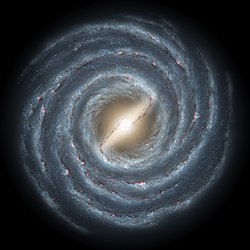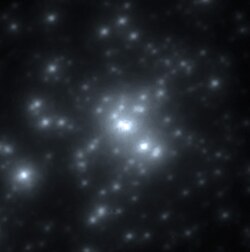Tarantula Nebula by JWST
Stellar nursery 30 Doradus gets its nickname of the Tarantula Nebula from its long, dusty filaments. Located in the Large Magellanic Cloud galaxy, it’s the largest and brightest star-forming region near our own galaxy, plus home to the hottest, most massive stars known.
The center of this image, taken by Webb’s Near-Infrared Camera instrument (NIRCam), has been hollowed out by the radiation from young, massive stars (seen in sparkling pale blue). Only the densest surrounding areas of the nebula resist erosion, forming the pillars that appear to point back towards the cluster of stars in the center. The pillars are home to still-forming stars, which will eventually leave their dusty cocoons and help shape the nebula.
Fluffy tan-colored nebula clouds, with rust-colored highlights, surround a black central area. Within that area, the focal point of the image is one large yellow star with eight long thin points. To the right of this star is a bright star cluster in an oval shape. The stars within the cluster look like tiny pale blue sparkles. The cluster is more densely packed at its core and scatters outward. Towards the bottom of the image, multiple arms appear to spiral out of a cloudy tan knob, resembling a spider or a squid structure. Other blue and yellow eight-pointed stars, as well as distant galaxies, are dotted throughout the image.Relevante Bilder
Relevante Artikel
Große Magellansche WolkeDie Große Magellansche Wolke, abgekürzt GMW oder LMC, ist eine Satellitengalaxie der Milchstraße (Galaxis). Sie befindet sich in einer Entfernung von rund 163.000 Lichtjahren zum Sonnensystem. Sie ist das viertgrößte Mitglied der Lokalen Gruppe, nur übertroffen von Milchstraße, Andromeda- und Dreiecksgalaxie. Mit ihren rund 15 Milliarden Sternen kommt sie auf etwa 5 % der Anzahl der Sterne der Milchstraße und dreimal so viele Sterne wie die ihr in vielerlei Hinsicht ähnliche Kleine Magellansche Wolke. Große und Kleine Magellansche Wolke werden zusammenfassend als Magellansche Wolken bezeichnet. .. weiterlesen
30 Doradus30 Doradus ist die Bezeichnung eines in der Großen Magellanschen Wolke im Sternbild Schwertfisch (Dorado) gelegenen, sehr hellen Emissionsnebels. Er ist eines der größten bekannten Sternentstehungsgebiete in der lokalen Gruppe und trotz seiner Entfernung von rund 50 kpc schon in kleinen Fernrohren zu sehen. Er hat einen Durchmesser von 30′ × 20′ und eine scheinbare Helligkeit von 8,0 mag. .. weiterlesen











